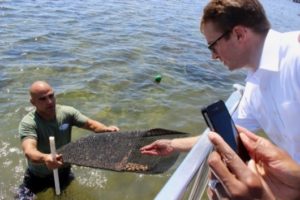Consistent with the National Shellfish Sanitation Program, the RI Department of Environmental Management’s (RIDEM) Office of Water Resources monitors the quality of the state’s shellfish growing areas by testing the water in shellfish growing areas for levels of fecal coliform—an indicator of bacterial contamination, identifying potential and actual pollution sources that may affect the water quality, and by monitoring waters for HABs. For more information regarding whether shellfish harvesting is permitted in a particular growing area, visit the State Shellfish Water Quality Monitoring website.

Shellfish growing areas include Narragansett Bay, its shellfish harboring tributaries, all of the south shore coastal salt ponds and offshore waters, Little Narragansett Bay, and the waters of Great Salt Pond and the offshore waters surrounding Block Island. Sampling is conducted 6-12 times each year at over 300 established sampling stations distributed throughout all the growing areas.
Results are used in conjunction with shoreline surveys, which identify potential pollution sources, and routine biotoxin monitoring to ensure that shellfish are only harvested from waters having acceptable water quality. The program also monitors and institutes emergency closures of shellfish waters due to conditions such as extreme weather events that cause flooding, power outages, and malfunctions or overflows at wastewater treatment facilities that discharge to these waters—all of which can lead to unsafe levels of bacteria. Follow-up sampling is then conducted until acceptable bacteria levels are reached, which is required prior to reopening an area following an extreme weather or infrastructure failure event.
The RIDEM Marine Fisheries Section monitors shellfish population levels by conducting an annual survey for quahogs in Narragansett Bay. They use a specialized dredge to dislodge shellfish from the sediment as it is dragged along the bottom of the bay. These data are used to assess the quahog stock and inform quahog management decisions. For more information, see RIDEM’s Shellfish Management Plan.
